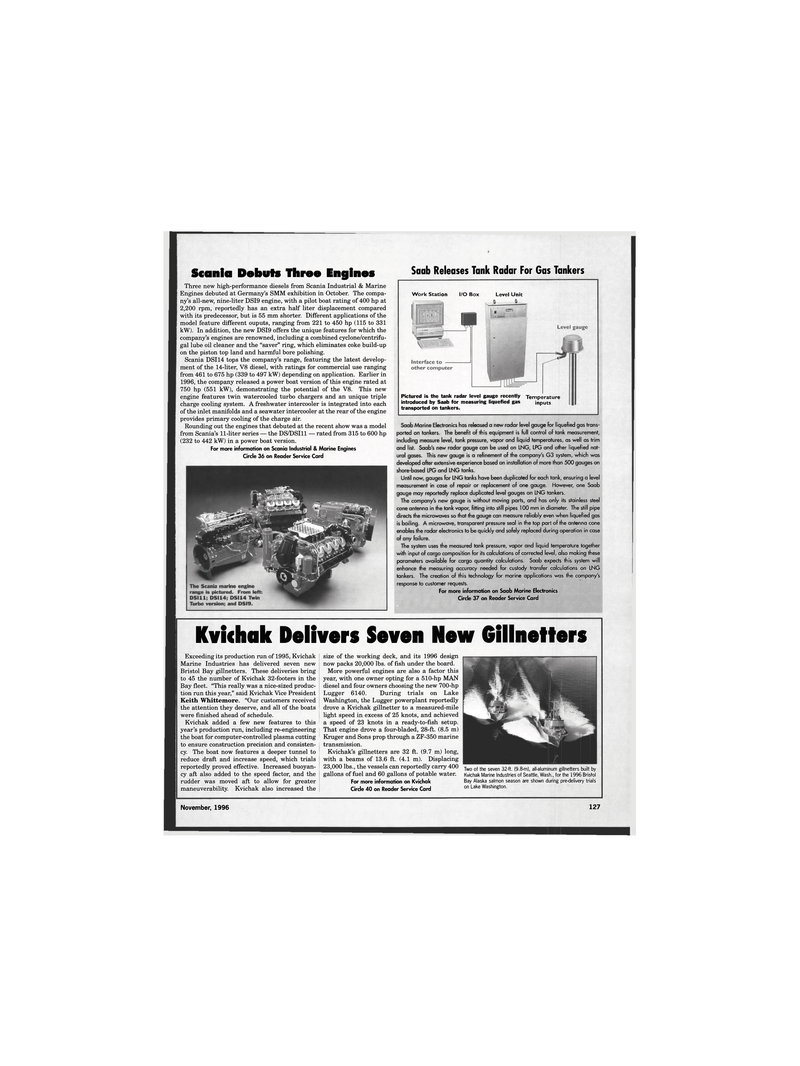
Page 125: of Maritime Reporter Magazine (November 1996)
Read this page in Pdf, Flash or Html5 edition of November 1996 Maritime Reporter Magazine
Scania Debuts Three Engines
Three new high-performance diesels from Scania Industrial & Marine
Engines debuted at Germany's SMM exhibition in October. The compa- ny's all-new, nine-liter DSI9 engine, with a pilot boat rating of 400 hp at 2,200 rpm, reportedly has an extra half liter displacement compared with its predecessor, but is 55 mm shorter. Different applications of the model feature different ouputs, ranging from 221 to 450 hp (115 to 331 kW). In addition, the new DSI9 offers the unique features for which the company's engines are renowned, including a combined cyclone/centrifu- gal lube oil cleaner and the "saver" ring, which eliminates coke build-up on the piston top land and harmful bore polishing.
Scania DSI14 tops the company's range, featuring the latest develop- ment of the 14-liter, V8 diesel, with ratings for commercial use ranging from 461 to 675 hp (339 to 497 kW) depending on application. Earlier in 1996, the company released a power boat version of this engine rated at 750 hp (551 kW), demonstrating the potential of the V8. This new engine features twin watercooled turbo chargers and an unique triple charge cooling system. A freshwater intercooler is integrated into each of the inlet manifolds and a seawater intercooler at the rear of the engine provides primary cooling of the charge air.
Rounding out the engines that debuted at the recent show was a model from Scania's 11-liter series — the DS/DSI11 — rated from 315 to 600 hp (232 to 442 kW) in a power boat version.
For more information on Scania Industrial & Marine Engines
Circle 36 on Reader Service Card
Saab Releases Tank Radar For Gas Tankers
Saab Marine Electronics has released a new radar level gauge for liquefied gas trans- ported on tankers. The benefit of this equipment is full control of tank measurement, including measure level, tank pressure, vapor and liquid temperatures, as well as trim and list. Saab's new radar gauge can be used on LNG, LPG and other liquefied nat- ural gases. This new gauge is a refinement of the company's G3 system, which was developed after extensive experience based on installation of more than 500 gauges on shore-based LPG and LNG tanks.
Until now, gauges for LNG tanks have been duplicated for each tank, ensuring a level measurement in case of repair or replacement of one gauge. However, one Saab gauge may reportedly replace duplicated level gauges on LNG tankers.
The company's new gauge is without moving parts, and has only its stainless steel cone antenna in the tank vapor, fitting into still pipes 100 mm in diameter. The still pipe directs the microwaves so that the gauge can measure reliably even when liquefied gas is boiling. A microwave, transparent pressure seal in the top part of the antenna cone enables the radar electronics to be quickly and safely replaced during operation in case of any failure.
The system uses the measured tank pressure, vapor and liquid temperature together with input of cargo composition for its calculations of corrected level, also making these parameters available for cargo quantity calculations. Saab expects this system will enhance the measuring accuracy needed for custody transfer calculations on LNG tankers. The creation of this technology for marine applications was the company's response to customer requests.
For more information on Saab Marine Electronics
Circle 37 on Reader Service Card
Work Station I/O Box Level Unit
Pictured is the tank radar level gauge recently Temperature introduced by Saab for measuring liquefied gas inputs transported on tankers.
Kvichak Delivers Seven New Gillnetters
Exceeding its production run of 1995, Kvichak
Marine Industries has delivered seven new
Bristol Bay gillnetters. These deliveries bring to 45 the number of Kvichak 32-footers in the
Bay fleet. "This really was a nice-sized produc- tion run this year," said Kvichak Vice President
Keith Whittemore. "Our customers received the attention they deserve, and all of the boats were finished ahead of schedule.
Kvichak added a few new features to this year's production run, including re-engineering the boat for computer-controlled plasma cutting to ensure construction precision and consisten- cy. The boat now features a deeper tunnel to reduce draft and increase speed, which trials reportedly proved effective. Increased buoyan- cy aft also added to the speed factor, and the rudder was moved aft to allow for greater maneuverability. Kvichak also increased the size of the working deck, and its 1996 design now packs 20,000 lbs. of fish under the board.
More powerful engines are also a factor this year, with one owner opting for a 510-hp MAN diesel and four owners choosing the new 700-hp
Lugger 6140. During trials on Lake
Washington, the Lugger powerplant reportedly drove a Kvichak gillnetter to a measured-mile light speed in excess of 25 knots, and achieved a speed of 23 knots in a ready-to-fish setup.
That engine drove a four-bladed, 28-ft. (8.5 m)
Kruger and Sons prop through a ZF-350 marine transmission.
Kvichak's gillnetters are 32 ft. (9.7 m) long, with a beams of 13.6 ft. (4.1 m). Displacing 23,000 lbs., the vessels can reportedly carry 400 gallons of fuel and 60 gallons of potable water.
For more information on Kvichak
Circle 40 on Reader Service Card
Two of the seven 32-ft. (9.8-m), all-aluminum gillnetters built by
Kvichak Marine Industries of Seattle, Wash., for the 1996 Bristol
Bay Alaska salmon season are shown during pre-delivery trials on Lake Washington.
November, 1996 127

 124
124

 126
126
